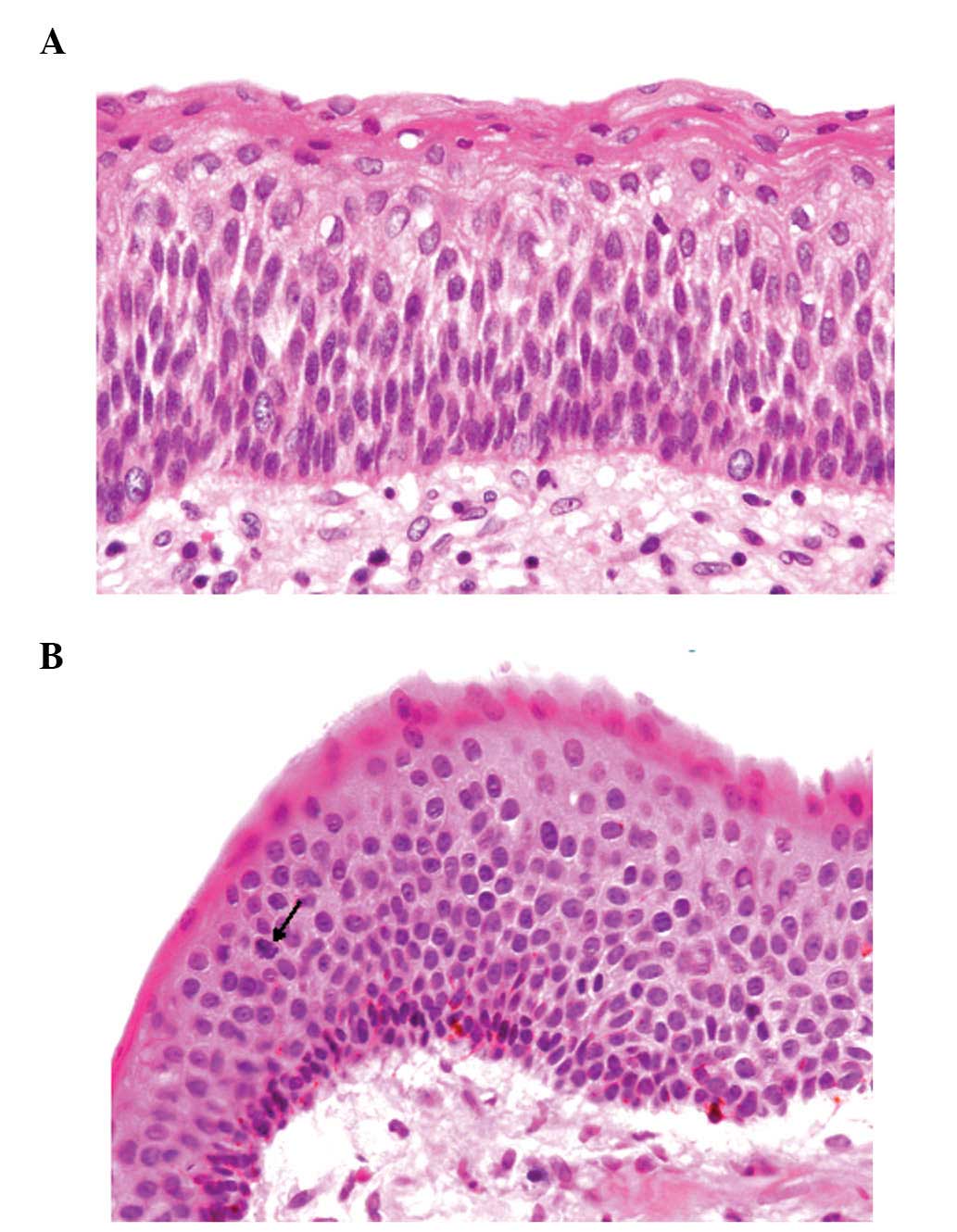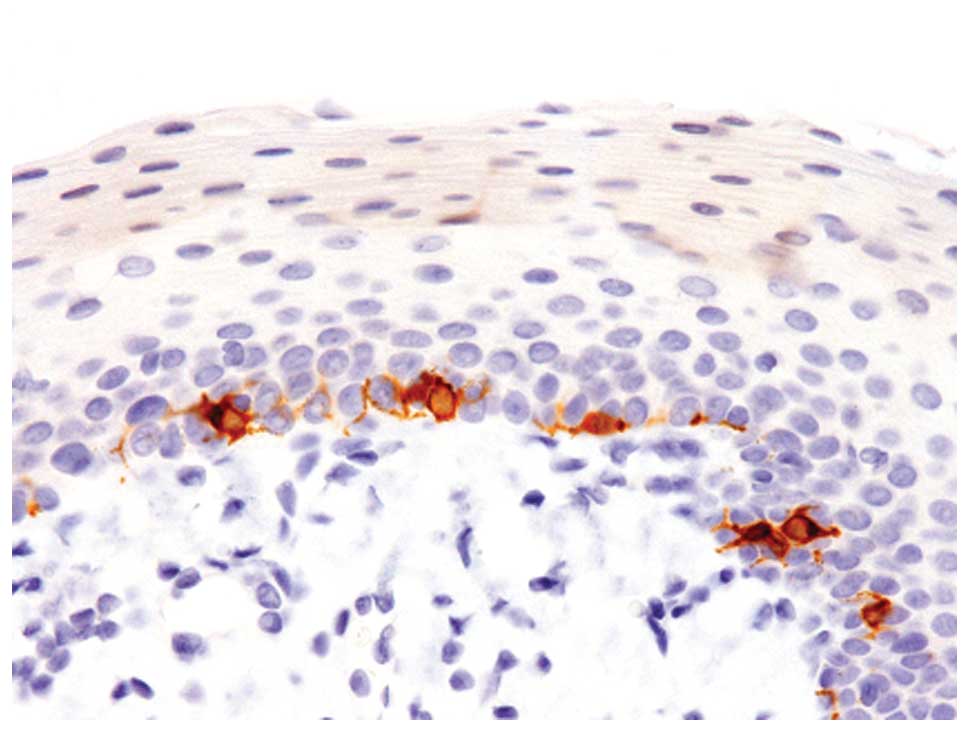Pigmented keratocystic odontogenic tumor: A case report with review of the literature
- Authors:
- Published online on: February 28, 2013 https://doi.org/10.3892/mco.2013.81
- Pages: 430-432
Abstract
Introduction
Keratocystic odontogenic tumor (KCOT), previously referred to as odontogenic keratocyst, is a relatively rare benign intraosseous neoplasm of odontogenic origin that is histopathologically characterized by the presence of a lining of parakeratinized stratified squamous epithelium. Squamous cell lesions, such as squamous cell carcinoma (SCC) and intraepithelial squamous neoplasia, usually lack melanocytes within the tumor. However, a few reports on invasive SCC or intraepithelial squamous neoplasia with melanocytic hyperplasia, namely pigmented SCC, have been reported in certain organs, such as skin, oral mucosa, nasal cavity and uterine cervix (1–4). The squamous epithelium of KCOT usually does not contain melanocytes, however, cases of pigmented KCOT have been documented, albeit extremely rarely (5–8). In the present study, we described an additional case of pigmented KCOT and review the clinicopathological features of this extremely rare lesion. This study was approved by the ethics committee of Shiga University of Medical Science. Informed consent was obtained from the patient.
Case report
A 23-year-old Japanese female presented with right odontalgia. X-ray demonstrated a relatively well-circumscribed round unilocular radiolucency, measuring ∼20 mm, that impacted the third molar in her right mandible. Surgical resection of the mandibular cystic lesion was performed following a clinical diagnosis of KCOT.
The formalin-fixed, paraffin-embedded tissue block of the resected mandibular specimen was cut into 3-μm sections, deparaffinized and rehydrated. The sections were stained with hematoxylin and eosin (H&E) and submitted for immunostaining. Immunohistochemical analyses were performed using an autostainer (Benchmark XT system; Ventana Medical System, Tucson, AZ, USA) according to the manufacturer’s instructions. The following primary antibodies were used: a mouse monoclonal antibody against HMB-45 (HMB-45; Novocastra Laboratories, Ltd., Newcastle upon Tyne, UK), a mouse monoclonal antibody against Melan-A (A103; Novocastra LAboratories) and a rabbit polyclonal antibody against S-100 protein (Nichirei Biosciences, Inc., Tokyo, Japan).
Results
Histopathological study of the resected mandibular cyst showed that the cyst was covered by a parakeratinized stratified squamous epithelium without rete ridges (Fig. 1A). The squamous epithelial cells had slightly enlarged hyperchromatic nuclei (Fig. 1A). On the luminal surface, a wavy layer of parakeratin was observed. Mitotic figures were found in the suprabasal layer of the squamous epithelium (Fig. 1B). Mild lymphocytic infiltration was present in the cyst wall. The above-mentioned histopathological features are typical of KCOT. Besides these findings, dendritic melanocytes without atypia were observed in approximately half of the squamous epithelium of the cyst wall (Fig. 1B). Basal cells that contained melanin pigment within the cytoplasm were rarely identified.
Immunohistochemical analyses revealed that these melanocytes were positive for S-100 protein, Melan-A and HMB-45 (Fig. 2).
According to these histopathological and immunohistochemical findings, an ultimate diagnosis of pigmented KCOT was made.
Discussion
A noteworthy finding of this study is the presence of melanocytes in the squamous epithelium of KCOT, referred to as pigmented KCOT. Table I summarizes the clinicopathological features of the previously reported cases of pigmented KCOT as well as the present case (5–8). This lesion mostly occurs in young persons (average age 18, years; range, 11–26) and shows female predominance (male:female ratio of 2:5). The majority of cases were solitary (6/9 cases) and involved the mandibula (only one multiple case was shown to involve the maxilla as well as the mandibula). The reported incidences of pigmented KCOT are 0.9% (1/104 cases) and 0.36% (1/278 cases) (5,6). These patients were of West Indian and African origins, respectively (Table I). However, Takeda et al(7) reported that the prevalence of pigmented KCOT was 10.6% (5/47 cases) in the Japanese population and this difference in frequency of pigmented KCOT may be related to ethnicity (7).
Takeda et al(7) reported a series of pigmented KCOT and they described two distinct histopathological patterns of this lesion. In the first pattern, numerous melanocytes are scattered in the basal layer and inconspicuous melanin pigment is present in the basal squamous cells, as observed in the present case. In the other pattern, dendritic melanocytes are inconspicuous within the lining epithelium, but basal squamous cells contain abundant melanin pigment within the cytoplasm (7). In the series, four of five cases showed the first pattern (7).
Pigmented jaw lesions have been documented in other odontogenic tumors in addition to KCOT, such as calcifying epithelial odontogenic tumor, adenomatoid odontogenic tumor and dentigerous cyst (9). The mechanisms by which melanocytes and/or melanin pigment appear in odontogenic tumors remain unclear. However, potential explanations have been suggested. One possible origin of melanocytes involves the migration of melanocytes through the mesenchyme, while another proposal is that melanocytes form part of the oral epithelium (9).
In conclusion, we have described the ninth reported case of pigmented KCOT. The mechanism by which melanocytes and/or melanin pigment appear in KCOT and the ethnic difference in the prevalence of pigmented KCOT remain unclear. Additional clinicopathological studies are needed to clarify these issues.
References
|
Morgan MB, Lima-Maribona J, Miller RA, Kilpatrick T and Tannenbaum M: Pigmented squamous cell carcinoma of the skin: morphologic and immunohistochemical study of five cases. J Cutan Pathol. 27:381–386. 2000. View Article : Google Scholar : PubMed/NCBI | |
|
Mathews A, Abraham EK, Amman S and Nair MK: Pigmented squamous cell carcinoma of nasal cavity. Histopathology. 33:184–185. 1998. View Article : Google Scholar : PubMed/NCBI | |
|
Mikami T, Furuya I, Kumagai A, et al: Pigmented squamous cell carcinoma of oral mucosa: clinicopathologic study of 3 cases. J Oral Maxillofac Surg. 70:1232–1239. 2012. View Article : Google Scholar : PubMed/NCBI | |
|
Ishida M, Kagotani A, Yoshida K and Okabe H: Pigmented cervical intraepithelial neoplasia. Int J Gynecol Pathol. (In press). | |
|
Browne RM: The odontogenic keratocyst. Histologic features and their correlation with clinical behavior. Br Dent J. 131:249–259. 1971. View Article : Google Scholar : PubMed/NCBI | |
|
Brannon RB: The odontogenic keratocyst. A clinicopathologic study of 312 cases. Part II Oral Surg Oral Med Oral Pathol. 43:233–255. 1977.PubMed/NCBI | |
|
Takeda Y, Kuroda M, Kuroda M, Suzuki A and Fujioka Y: Melanocytes in odontogenic keratocyst. Acta Pathol Jpn. 35:899–903. 1985.PubMed/NCBI | |
|
Macleod RI, Fanibunda KB and Soames JV: A pigmanted odontogenic keratocyst. Br J Oral Maxillofac Surg. 23:216–219. 1985. View Article : Google Scholar | |
|
Takeda Y and Yamamoto H: Case report of a pigmented dentigerous cyst and a review of the literature on pigmented odontogenic cysts. J Oral Sci. 42:43–46. 2000. View Article : Google Scholar : PubMed/NCBI |











